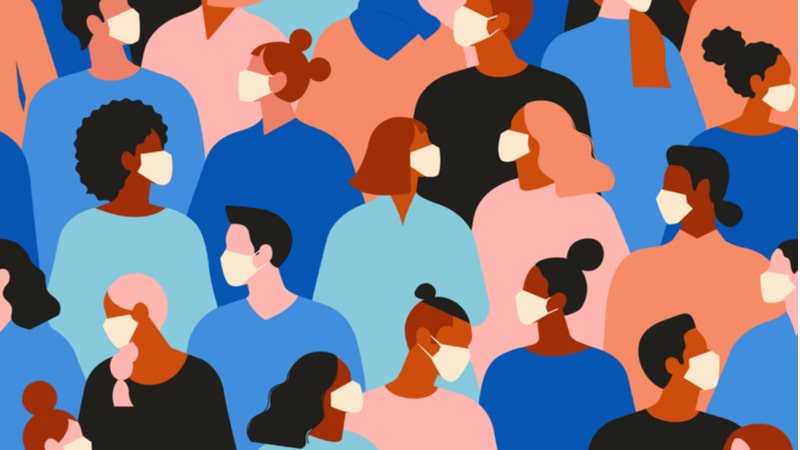
As the COVID-19 coronavirus spreads throughout the United States, it’s nearly impossible to keep up with the most up-to-date news on the pandemic.
Within any atmosphere of data overload, it’s inevitable that unreliable information, confusion, and even scams can take root. That’s why it’s increasingly important to stick to the most trusted sources for information – such as the World Health Organization (WHO), the Centers for Disease Control and Prevention (CDC), and medical professionals – when weighing the facts that go into critical decisions including those involving your health.
To help navigate some of the most prevailing rumors, we tested some of the top COVID-19 cause, prevention, and treatment myths against a range of generally trusted information sources. Here’s what we found out, with information links so that you can read more about it:
Myth: 5G caused the COVID-19 outbreak.
Fact: 5G wireless technology development, testing, and (more recently) deployment have been underway for years. By all accounts, the timeline of Chinese 5G deployments and the COVID-19 outbreak in Wuhan is merely coincidental, and links between the two appear to stem from spiraling online rumors. In fact, a study published last month found no causal connection between 5G and health detriments.
Myth: Warm (or cold) weather will kill the coronavirus.
Fact: Coronavirus can be spread in virtually all climates, and there is no current evidence to show that a shift in weather will slow the spread. COVID-19 has been found in hot and humid areas as well as more temperate climates, and can live on the human body regardless of outside temperature, according to the World Health Organization.
Myth: Younger people don’t have to worry about contracting coronavirus.
Fact: Anyone can contract the virus. The CDC reported that one in five United States COVID-19 cases occurred in individuals aged 20 to 44, and half of individuals hospitalized were under 65 years old. While younger individuals are less likely to die from the virus, they can easily spread it to more susceptible populations.
Myth: COVID-19 is only as dangerous as the common flu.
Fact: The World Health Organization outlined key differences between COVID-19 and the annual flu to demonstrate why more extensive prevention measures are necessary. Among those findings: The percent of severe and critical infections caused by COVID-19 is higher than the flu. Mortality appears to be higher for COVID-19, although mortality is also determined by access to quality healthcare. COVID-19 can survive on some surfaces for up to six days, while the flu can only survive for three. And early studies show that most COVID-19 transmission comes stems from adults, compared to the flu which is largely spread by children.
Myth: COVID-19 is a death sentence.
Fact: Not so. About 80 percent of COVID-19 infections are mild or asymptomatic, according to the WHO reference mentioned above. Social distancing, however, is still important to prevent the spread of the disease to vulnerable populations, and even mild symptoms can make for a rough time.
Myth: But I don’t encounter any members of high-risk populations…
Fact: You probably do. A Kaiser Family Foundation report found that 40 percent of Americans could be considered a member of a high-risk population during the COVID-19 pandemic. As the University of California San Francisco pointed out, this includes the 76.3 million Americans over the age of 60, and 29.3 million younger adults with underlying health conditions.
Myth: Social distancing requires members of the public to stay indoors.
Fact: Social distancing is a critical way to flatten the infection curve and reduce the spread of coronavirus, but it mainly entails staying at least six feet away from other people and avoiding crowds. Hiking, sports such as tennis, and buying groceries are all still possible while maintaining social distancing.
Self-quarantine is recommended for those at risk to catch the disease, which involves a stricter requirement to remain at home, John Hopkins Medicine explains. That said, state and local governments are rolling out stay-at-home orders and other provisions that may affect your ability to participate in non-essential activities. Check those before going out.
Myth: Stocking up on food, paper products, and other necessities is critical.
Fact: As mentioned above, you can still go shopping for essentials under the guidelines of social distancing and during many stay-at-home orders, but it’s important to maintain certain key precautions. Wash your hands frequently or consider a no-contact grocery drop-off. It’s also wise to reduce your grocery store runs and interactions with the public to once or twice a week at the most, Chief of the Division of Infectious Diseases at Stony Brook University Bettina Fries recommended in the Washington Post.
Hoarding goods can prevent access to necessities for other members of your community, and Federal agencies are cracking down on medical supply hoarders.
Myth: The general public should be wearing masks.
Fact: This is a tricky issue, and official views may be changing, so it’s important to frequently check back with CDC guidelines. The current advice is to assume “everyday preventive actions” such as avoiding people who are sick, not touching your face, and washing your hands. But the White House coronavirus task force is expected to come out with an updated mask guidance in the coming days.
Myth: Vaccines are currently available.
Fact: While vaccines are in development, no vaccine currently exists to prevent COVID-19. Scammers are currently trying to exploit fear around the virus by selling fraudulent, ineffective or fake vaccines, and the Department of Justice is acting swiftly to shut them down.
Myth: Ingesting bleach, acid, essential oils, or other substances not recommended by a doctor will help cure or prevent the virus.
Fact: PLEASE contact a trusted medical professional before following internet medical advice. To date, no specific medicines are recommended by WHO to treat or prevent COVID-19.
Follow Federal Emergency Management Agency Coronavirus Rumor Control Guidelines by referring to trusted sources of information for all COVID-19 news. Report COVID-19 related scams to the Federal Trade Commission.
